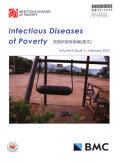- 钛学术文献服务平台 \
- 学术期刊 \
- 医药卫生期刊 \
- 内科学期刊 \
- 贫困所致传染病(英文)期刊 \
Reaching the last mile: main challenges relating to and recommendations to accelerate onchocerciasis elimination in Africa
Reaching the last mile: main challenges relating to and recommendations to accelerate onchocerciasis elimination in Africa
基本信息来源于合作网站,原文需代理用户跳转至来源网站获取
摘要:
Background::Onchocerciasis (river blindness), caused by the filarial worm species
Onchocerca volvulus, is a serious vector-borne neglected tropical disease (NTD) of public health and socioeconomic concern. It is transmitted through the bite of black flies of the genus
Simulium, and manifested in dermal and ocular lesions. Ninety-nine percent of the total global risk and burden of onchocerciasis is in Africa. This scoping review examines the key challenges related to the elimination of onchocerciasis by 2020-2025 in Africa, and proposes recommendations to overcome the challenges and accelerate disease elimination. To find relevant articles published in peer-reviewed journals, a search of PubMed and Google Scholar databases was carried out.
Main text::Rigorous regional interventions carried out to control and eliminate onchocerciasis in the past four decades in Africa have been effective in bringing the disease burden under control; it is currently not a public health problem in most endemic areas. Notably, transmission of the parasite is interrupted in some hyperendemic localities. Recently, there has been a policy shift from control to complete disease elimination by 2020 in selected countries and by 2025 in the majority of endemic African countries. The WHO has published guidelines for stopping mass drug administration (MDA) and verifying the interruption of transmission and elimination of human onchocerciasis. Therefore, countries have revised their plans, established a goal of disease elimination in line with an evidence based decision to stop MDA and verify elimination, and incorporated it into their NTDs national master plans. Nevertheless, challenges remain pertaining to the elimination of onchocerciasis in Africa. The challenge we review in this paper are: incomplete elimination mapping of all transmission zones, co-endemicity of onchocerciasis and loiasis, possible emergence of ivermectin resistance, uncoordinated cross-border elimination efforts, conflict and civil unrest, suboptimal program implementation, and technical and financial challenges. This paper also proposes recommendations to overcome the challenges and accelerate disease elimination. These are: a need for complete disease elimination mapping, a need for collaborative elimination activities between national programs, a need for a different drug distribution approach in conflict-affected areas, a need for routine monitoring and evaluation of MDA programs, a need for implementing alternative treatment strategies (ATSs) in areas with elimination anticipated beyond 2025, and a need for strong partnerships and continued funding.Conclusions::National programs need to regularly monitor and evaluate the performance and progress of their interventions, while envisaging the complete elimination of onchocerciasis from their territory. Factors hindering the targeted goal of interruption of parasite transmission need to be identified and remedial actions should be taken. If possible and appropriate, ATSs need to be implemented to accelerate disease elimination by 2025.

推荐文章
Geochemistry and sediment in the main stream of the Ca River basin, Vietnam: weathering process, sol
Ca River
Dissolved solids
Geochemistry
Carbonate weathering
Suspended solids
Orem自理模式在直肠癌Mile's术后病人护理中的应用
Orem自理模式
直肠癌
Mile's术
护理
生活质量
内容分析
关键词云
关键词热度
相关文献总数
(/次)
(/年)
文献信息
| 篇名 | Reaching the last mile: main challenges relating to and recommendations to accelerate onchocerciasis elimination in Africa | ||
| 来源期刊 | 贫困所致传染病(英文) | 学科 | |
| 关键词 | Onchocerciasis Elimination Challenge Africa | ||
| 年,卷(期) | 2019,(4) | 所属期刊栏目 | Scoping Review |
| 研究方向 | 页码范围 | 1-20 | |
| 页数 | 20页 | 分类号 | |
| 字数 | 语种 | 中文 | |
| DOI | 10.1186/s40249-019-0567-z | ||
五维指标
引文网络
引文网络
二级参考文献 (27)
共引文献 (6)
参考文献 (14)
节点文献
引证文献 (0)
同被引文献 (0)
二级引证文献 (0)
1968(1)
- 参考文献(1)
- 二级参考文献(0)
1987(1)
- 参考文献(1)
- 二级参考文献(0)
1988(2)
- 参考文献(0)
- 二级参考文献(2)
1991(1)
- 参考文献(0)
- 二级参考文献(1)
1992(1)
- 参考文献(1)
- 二级参考文献(0)
1995(1)
- 参考文献(0)
- 二级参考文献(1)
1996(1)
- 参考文献(0)
- 二级参考文献(1)
1998(1)
- 参考文献(0)
- 二级参考文献(1)
2000(1)
- 参考文献(1)
- 二级参考文献(0)
2003(1)
- 参考文献(1)
- 二级参考文献(0)
2004(1)
- 参考文献(0)
- 二级参考文献(1)
2005(1)
- 参考文献(0)
- 二级参考文献(1)
2006(2)
- 参考文献(0)
- 二级参考文献(2)
2007(2)
- 参考文献(0)
- 二级参考文献(2)
2008(3)
- 参考文献(1)
- 二级参考文献(2)
2009(3)
- 参考文献(1)
- 二级参考文献(2)
2010(2)
- 参考文献(0)
- 二级参考文献(2)
2011(1)
- 参考文献(0)
- 二级参考文献(1)
2012(1)
- 参考文献(0)
- 二级参考文献(1)
2013(6)
- 参考文献(4)
- 二级参考文献(2)
2014(3)
- 参考文献(0)
- 二级参考文献(3)
2015(1)
- 参考文献(0)
- 二级参考文献(1)
2016(2)
- 参考文献(1)
- 二级参考文献(1)
2017(1)
- 参考文献(1)
- 二级参考文献(0)
2018(1)
- 参考文献(1)
- 二级参考文献(0)
2019(0)
- 参考文献(0)
- 二级参考文献(0)
- 引证文献(0)
- 二级引证文献(0)
研究主题发展历程
节点文献
Onchocerciasis
Elimination
Challenge
Africa
研究起点
研究来源
研究分支
研究去脉
引文网络交叉学科
相关学者/机构
期刊影响力
贫困所致传染病(英文)
主办单位:
中华医学会
出版周期:
双月刊
ISSN:
2095-5162
CN:
10-1399/R
开本:
出版地:
上海市黄浦区瑞金二路207号
邮发代号:
创刊时间:
2016
语种:
eng
出版文献量(篇)
434
总下载数(次)
0
总被引数(次)
45
期刊文献
相关文献
推荐文献

 免费查重
免费查重










